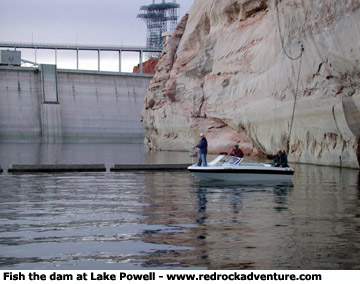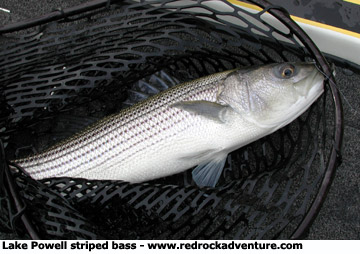
Spring Striper Fishing at Lake Powell
By Dave Webb
(Published 3-24-06)
 Fishing
is very good at Lake Powell right now and action is expected to get better
and better as the weather warms. Striped bass fishing should be excellent
on the lower lake through late May. Smallmouth and largemouth fishing
will be excellent lake-wide in April, May and June.
Fishing
is very good at Lake Powell right now and action is expected to get better
and better as the weather warms. Striped bass fishing should be excellent
on the lower lake through late May. Smallmouth and largemouth fishing
will be excellent lake-wide in April, May and June.
The reports have been so good, I decided I had to get down there and check it out for myself. I fished at Wahweap on April 21, when it was cold, windy and rainy, and caught a boatload of nice stripers. In three hours of fishing, six of us caught 45 fish like those you see in the photos, ranging in weight from about 4-6 pounds.
We could have stayed and caught more stripers but decided to head up to the Gunsight area and try for largemouth bass and walleye. The bass were hunkering down, waiting out the stormy weather, and so that action was slow. We managed to catch only two largemouth, one walleye and another striper before cold rain drove us from the water.
At Powell it is important to understand how fish respond to seasonal changes so you can key on productive spots. We had help in that regard because we were fishing with Wayne Gustaveson, the Utah Division of Wildlife Life Resources biologist in charge of the Lake Powell fishery, and with Ron Colby, a tournament bass fisherman who lives in Page, AZ. Their expertise certainly put us onto more fish than we would have found on our own, but action will be so good during the next several weeks that virtually all anglers should be able to find productive spots.
During spring, incredible numbers of striped bass migrate to the top and bottom of Lake Powell, propelled by the urge to spawn in moving water. They stage out from the lake’s major tributaries (the Colorado and San Juan rivers), and also in front of the dam (where water flows through the outlets).
Stripers are predators and forage on small shad. This year, shad are abundant on the upper lake but scarce down near the dam. As a result, fish staging near the inlets are big, fat and lazy while those on the lower lake are a little thinner and are hungry. At the top of the lake you will probably catch fewer but bigger fish. At the dam and you can catch fish all day long.
 We
found great action working the canyon walls, as close to the dam as we
could get. We positioned our boats about 40 feet (easy casting distance)
out from the cliff and then cast anchovies up against the wall. We were
using half an anchovy on a leadhead jig (1/8 oz), so the bait sank at
a medium rate, arching downward until it was directly under the boat.
Often a striper would pick up the anchovy as it sank.
We
found great action working the canyon walls, as close to the dam as we
could get. We positioned our boats about 40 feet (easy casting distance)
out from the cliff and then cast anchovies up against the wall. We were
using half an anchovy on a leadhead jig (1/8 oz), so the bait sank at
a medium rate, arching downward until it was directly under the boat.
Often a striper would pick up the anchovy as it sank.
A barricade prevents boats from approaching the dam. You can usually find good fishing at the point where the barricade touches the cliff on the west side of the lake. Other spots along the canyon walls are also good.
Stripers are nomadic, constantly moving, using the canyon walls as pathways. A school would move through and everyone would get bites. We often had 2-3 fish on simultaneously. Then the fish would move out and action would slow until another school moved in.
Fishermen have learned to identify productive spots. During spring you will almost always find boats fishing the "corner" where the barricade touches the canyon wall. The first boat to reach that spot in the morning often enjoys a couple hours of exceptional fishing, but other spots along the walls can be just as productive.
Buoys are used to mark the main channel distance from the dam; there is often very good fishing along the cliff adjacent to Buoy #1. The first couple points on the north wall inside Antelope Canyon also offer good springtime action, along with the main channel cliff under the power plant intake, located between Antelope and Navajo canyons.
I’m just highlighting a few of the better spots. Stripers move along the walls all through that area and so there are plenty of places to fish, and plenty of fish to be caught.
The stripers were not yet in spawning mode when I was there–we caught fish that had wintered in the area. More fish will migrate into spawning areas as the lake’s water temperature rises in April. The action should get better and better during the next few weeks.
 Spring
brings runoff that muddies the water on the upper lake. Sometimes muddy
water will extend for several miles below the mouths of the Colorado and
San Juan rivers. A large number of stripers can usually be found right
at the edge of the mud lines (where muddy water gives way to clear lake
water). It can be productive fishing anchovies in those areas and fish
may also hit shad-imitating lures trolled or reeled through the schools.
Spring
brings runoff that muddies the water on the upper lake. Sometimes muddy
water will extend for several miles below the mouths of the Colorado and
San Juan rivers. A large number of stripers can usually be found right
at the edge of the mud lines (where muddy water gives way to clear lake
water). It can be productive fishing anchovies in those areas and fish
may also hit shad-imitating lures trolled or reeled through the schools.
Largemouth bass fishing should pick up lake-wide now and should be good whenever the weather is warm and stable. Smallmouth become active a couple weeks after the largemouth. There are incredible numbers of smallmouth in the reservoir and they will provide exceptional action on mild spring days.
Look for largemouth in tumbleweed tangles at the backs of canyons and coves. You’ll find smallmouth anywhere broken rock comes down into the water.
Both largemouth and smallmouth spawn in shallow water where gravel or cobblestones cover the bottom. If you look carefully you may be able to see them nesting.
Striped bass reproduce so well, they are overpopulated at the lake and there is no limit on the number an angler can harvest. Wayne insisted we keep every striper we caught. Anglers are effectively helping to reduce the striper population and creating a more healthy balance at the lake. The fish make tasty table fare.
Smallmouth are also common in Powell and biologists encourage anglers to keep a few. There is a 20-fish smallmouth limit. The largemouth limit is 5 fish.
Crappie and bluegill also provide good fishing at Powell during the spring. If you work the rocky structure or weeds near the back of a canyon on a fair day in late April, you can expect to catch bluegill, crappie, smallmouth, largemouth, walleye and stripers. Action can be good for any or all of those species.
Most of Lake Powell is located in Utah but the dam and parts of the lower lake are in Arizona. People over 14 years of age need a license from the respective state where they are fishing. Anglers licensed in Utah can purchase a $3 Arizona permit, allowing them to fish the entire lake.
Wayne updates a website that includes excellent, timely reports on fishing at Powell. Study it, if you want to learn to fish the lake: www.wayneswords.com.
In April the water at Powell is still chilly–too cold for most people to enjoy jet or water skiing. Those activities begin in earnest later in May. All ramps except Hite are open and marinas are fully functional. Boating conditions already excellent and the lake is not crowded. Spring is a great time to sightsee, explore the lake’s twisting canyons, camp and hike.
I had so much fun I’m hankering to go back. I hope to get down there again in late April or early May–the fishing should be incredible.
Copyright Dave Webb, 2006